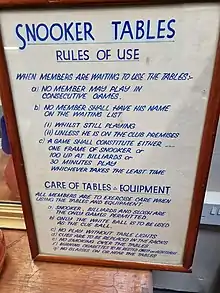Slosh (cue sport)
Slosh (also known as Russian billiards, Indian pool, Indian billiards, and toad-in-the-hole) is a cue sport played on a snooker table. The game features seven balls, coloured white (or a cue ball), yellow, green, brown, blue, pink and black, with points being scored for pocketing or playing caroms and cannons off object balls. The game is played to a score of 100 points, or a length of 30 minutes. First played in the early 1900s, not much is known about the game's origins.
Origin

Not much is known about the origins of slosh, other than the alternative name, Russian billiards, is unlikely to have come from Russian descent.[1] Slosh is likely to have been founded around the early 1900s, being derived with the cue sport of snooker from the game of black pool,[2] played with the same balls and table.[3][4][5] The game is sometimes known as Indian billiards or Indian pool.[6][7] These names are sometimes misappropriated to a table carrom game.[8] Other names for the game include toad-in-the-hole (not to be confused with Toad in the hole or the food of the same name)[9] and Russian pool,[9][10][11] although it is unknown why these names are used.[12][13]
Rules
The game is played with seven balls. These are a white cue ball, and six object balls in different colours: yellow, green, brown, blue, pink and black.[14][15] A game for two to four players; the first shot must be played towards the black ball, with points being scored for either pocketing the object ball, or playing carom shots, pocketing the cue ball. Points may only be scored by pocketing into certain pockets for each individual coloured ball.[1][16]
Slosh is played to a total of 100 points. A player can continue to stroke after completing any legal pot or carom. Points are awarded for each ball differently, with two points for a pot on the yellow, three for the green, four for the brown, five for the blue, six for the pink and seven for the black. Playing a cannon (hitting two object balls) is worth two points. To win, the player must finish on exactly 100 points, or be on the highest number of points after 30 minutes of play. If the shooter exceeds 100, the score is reduced to 50, but the player can continue their inning.[17][18]
Foul shots, such as potting a ball in the incorrect pocket, or playing an in-off results in points being either deducted from the player's points, or awarded to their opponent.[17][19]
References
- Shamos 2002, p. 208.
- "Snooker" and "Slosh". Hull Daily Mail. 10 February 1925. p. 3. Retrieved 2 April 2022 – via British Newspaper Archive.
- "Cradle Cannon Record". EABA. Archived from the original on 11 January 2020.
- "The origin of snooker: The Neville Chamberlain story". IBSF. Archived from the original on 16 January 2007.
- Bridges, T.C. ""Slosh," otherwise Indian Pool". Archived from the original on 6 February 2012. Retrieved 2 April 2022.
- "Billiard and Snooker Heritage Collection – Origins of Snooker". snookerheritage.co.uk. Archived from the original on 24 August 2019. Retrieved 2 April 2022.
- Thompson, Harry (5 April 2007). Penguins Stopped Play. John Murray Press. ISBN 9781848542648. Archived from the original on 2 April 2022. Retrieved 2 April 2022 – via Google Books.
- "Corporate name : Carrom Veda". French Export. Archived from the original on 6 February 2012. Retrieved 2 April 2022.
- Shamos 2002, p. 227.
- Smith 1924, p. 94.
- KTG 1954.
- Shamos 2002, pp. 260–261.
- Clarke, Gary (2 April 2008). A Billiards and Snooker Compendium. Paragon Publishing. pp. 54–55. ISBN 9781899820467. Archived from the original on 2 April 2022. Retrieved 2 April 2022 – via Google Books.
- BTSE 1957, p. 3.
- Shamos 2002, p. 208, 227.
- Phelan 2017, p. 37.
- "Canadian Russian Billiards Rules". billiardsforum.com. Archived from the original on 12 June 2021. Retrieved 2 April 2022.
- Stooke 1988, p. 19.
- Walker 1837, p. 5.
Bibliography
- Billiards and Snooker Teasers Explained (14 ed.). London: Burroughes and Watts. 1957. ASIN B07JCW8HQS.
- Handbook and Rules of - English Billiards - Snooker - Volunteer Snooker - Pool Pyramids - Russian Pool (Reprint ed.). Brunswich-Balke Collendar Co. 2010 [1911]. ISBN 9781445525457.
- Phelan, Michael (16 January 2017) [1850]. Billiards Without a Master (reprint ed.). New York: D.D. Winant. ISBN 9780282488246.
- Shamos, Michael I. (2002). The New Illustrated Encyclopedia of Billiards. New York: Lyons Press. ISBN 978-1-58574-685-9.
- Smith, Willie (1924). How to Play Snooker and Other Pool Games. Crawley: C.A. Pearson.
- Stooke, Mike (1988). Snooker Games: Games of the Snooker Table : Five of Today's Most Popular Alternative Games. Birmingham: Poolman. ISBN 9780951297704.
- Various (1954). Know the Game – Billiards and Snooker. ISBN 9781473390195.
- Walker, Donald (1837). Games and Sports: Being an Appendix to Manly Exercises and Exercises for Ladies, Containing the Various In-door Games and Sports, the Out-of-door Games and Sports, Those of the Seasons, &c. London: Thomas Hurst.
